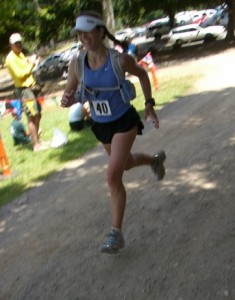
Striding out on one of my favorite trails in Tilden Park near Berkeley, California (photo by Corey Rich).
I have a love-hate relationship with the track. Weeks or months go by without me descending the stadium steps of our local high school to run laps. Maybe I’m still haunted by my junior high PE teacher hollering at me and all the other chubbies and misfits to pick up the pace. Or maybe I’m stressed by self-imposed expectations of precisely how fast I should run each 400-meter interval.
No matter what, though, I try to do a speed workout at least once a week.Why? Because it makes my legs zippy, it builds endurance, and I always feel better afterward, even on days when I’m more of Clydesdale than thoroughbred.
When I don’t feel like going to the track, or I’m traveling and a track isn’t available, then I do it on the open trail or road.

Do enough speed workouts, and you could run down a marathon finish chute like her, the winner of the 2009 Buenos Aires Marathon.
These off-track speed workouts can be so effective and fun that I often wonder, Why bother with track at all?
By “speed workout” I mean running beyond a comfortable zone in which conversation is possible. My meat-and-potatoes speed workout is a good-ol’ tempo run, during which at least 20 minutes is at the “comfortably hard” zone, or approximately 15 – 20 seconds slower than 10K race pace. For me, this translates to 6:45 – 6:50 per mile on flat terrain.
But breaking up the workout into intervals can be so much more fun than a steady 20+ minutes. I’m not kidding about “fun”!
Out in the open, I do intervals by time rather than distance. In other words, even though I have a Garmin that measures distance, I prefer to run an interval for a set amount of time, say 4 minutes. The beauty of time rather than distance intervals is it encourages more intuitive running—that is, running by feel. Run the pace that feels right for four minutes, and who cares whether the distance is 1000 or 1100 meters?
What follows if my favorite version of a do-anywhere speed workout: the 10, 8, 6, 4, 2. Do it, and you’ll accomplish 30 minutes of fast running.
- warm up by running easily for 10 minutes.
- Run the first interval, 10 minutes, at what feels like a tempo pace (“comfortably hard,” or about 15 – 20 seconds slower than a 10K race pace). Jog 2 minutes to recover.
- Run the second interval, 8 minutes, at what feels like a 10K race pace. Jog 2 minutes to recover.
- Run the third interval, 6 minutes, at slightly faster than a 10K pace. Jog for 2 minutes to recover.
- Run the fourth interval, 4 minutes, at what feels like a 5K or better pace. Jog for 2 minutes to recover.
- Give the final interval, 2 minutes, everything you’ve got left in you. Kick hard at the end. Run easily for 10 minutes to recover.

Speed workouts help me sprint to the finish of the Ohlone 50K, even when my legs felt trashed after 31 miles and 7800 feet of elevation gain.
Get it? You run a slightly faster pace each interval. Don’t worry if you don’t know what your 10K or 5K pace is. Just start at what feels “comfortably hard” — too hard to hold a conversation — and progress to what feels like sprinting for the 2-minute final interval.
Variation: Do two 5, 4, 3, 2, 1 workouts (intervals lasting half the time as the ones above, but at same pace), with only 1 minute rather than 2 minute recoveries between intervals.
Bonus: Do the 10, 8, 6, 4, 2 followed by the 5, 4, 3, 2, 1 for a total of 45 minutes fast running.
These workouts, by the way, also work great to break the monotony of a treadmill workout.

Good!! Of course I agree with you, cause this is a variation of my speed workout. The speed workout also is efficient – boosts your mileage in a shorter amount of time.